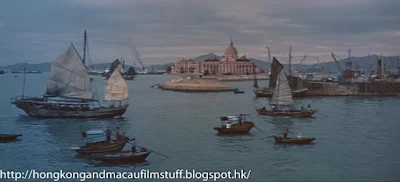Here's is one from some time ago that I never even bothered to look at because I figured it had long gone. But after wandering around Macau not so long ago I realised there was still some remnants of the location despite the 60 year gap.
The pier scenes in Macau were filmed at a real pier, and the number is recognisable on film, although lack of HD means it is not as clear as it should be. Anyway, the pier number is 27 and although the pier building itself has long gone (although many of the original buildings remain for other piers, some dating back to the 1940s), there is a nearby building that does still exist, although the ravages of time have seen its exterior change somewhat.
Here's a reminder of the pier that once sat along the waterfront on Avenida de Demetrio Cinatti.
Its modern day replacement is much larger and taller, but still occupies the same place along the road. here is the current Streetview.
Opposite the Pier building is an old tenement where, it is implied, Orson Welles' crooked captain keeps a girlfriend. She wanders out onto the balcony to give him a coy little wave as he is about the board the ferry back to Hong Kong. Here she is, followed by a picture of Welles looking suitably coquettish. You can see the lower ground of that same building behind Welles.
The building was, and still is, on the corner of Avenida de Demetrio Cinatti and the small side road (Travessa da Guelra) that connects with the Rua do Visconde Paco de Arcos. Here it is today, although standing it is not in the best of shape.
Look closely and you will be able to see some of the exterior embellishments that have been plastered over. One example is the centre of the side wall above which looks like it once had large rectangular door frame and lintel. If you look at the picture below, taken from both ends of Travessa da Guelra, you can see what it used to look like - positioned in between the two lower balcony supports. Alas, the balconies have also gone - these things are often the first to go in old buildings to ensure they don't get to the point where they prove dangerous. Here's another picture, this time taken from the pier side of the road.


















































